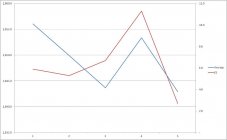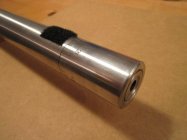Armored Transport said:
How about speed sorting your brass to stay with in an acceptable to you window. It works....

be kind of hard...all the brass I have is from the same lot of factory ammo. Unless there is something I'm missing.
My practice is to do a charge series, seating depth series and then tuner series. If I don't see at least a .4 grain charge window in the charge series, where velocity change is minimal and ES is low, I switch primers and try again. This window is usually seen just below full pressure and with powders a liitle on the fast side for the bullet-cartridge combination. All series are shot over a conventional chronograph and on targets for group. I don't really care about the groups in the charge series but shoot it that way for consistency. [br]
Here is a series with my .300 WSM and a new lot of H4831 SC, which proved to be a little slower than previous lots. The charge series (first graph) was five-shot groups, although I usually shoot three-shot. The seating depth series had no chrono data because I forgot the chrono. The tuner series of three-shot groups (second graph) mostly validated the charge series ES and resulted in a couple groups below .2" at 100 yards. The seating depth and tuner series were shot at 66.5 grains as the charge series was shot at 65° and we usually shoot matches at a little higher temperature. It was 80° during the tuner series. Note the modest velocity increase in the charge window from 66.4 to 66.9 and consistent, low ES. This is what I'm trying to obtain. The end goal is to align the charge window, seating depth and tuner settings to achieve the most tolerant configuration possible. The third image is the tuner series target. Note the repeating pattern of small-3 large-small-3 large. This is typical of what I see when setting the tuner. The barrel on this rifle is Ø1.25" straight and 34" long.
-

charge_series.jpg
55.2 KB
· Views: 114
-

tuner_series.jpg
29.8 KB
· Views: 110
-

300wsm_tuner_series.jpg
82.7 KB
· Views: 124
Steve,
That was a most refreshing and illuminating presentation. I assume the tuner series X axis demarcations are the tuner nominal settings? (Sorry, not familiar with tuners.)
Have you applied this approach to any smaller cartridges?
brians356 said:
Steve,
That was a most refreshing and illuminating presentation. I assume the tuner series X axis demarcations are the tuner nominal settings? (Sorry, not familiar with tuners.)
Have you applied this approach to any smaller cartridges?
[br]
Yes, the numbers are those on the tuner. They are just arbitrary numbers used for reference. It is a Cortina Tuner per the attached picture. [br]
This is the way I do load development for all my competition rifles, 6BR, .284 Shehane and .300 WSM.
-

Cortina_tuner.jpg
40.1 KB
· Views: 56
Steve,
What weight bullet were these data for? (Just getting a feel for your tested charge range from Hodgdon's data.)
These were Berger 230 Hybrids in Norma .270 WSM cases reformed to .300 WSM. The COAL was 3.268", as determined by the seating depth test. That represents .025" jump from touching.
Thanks.
I notice on the tuner series target that the 3 different "small" sequences (or partial ones) printed at progressively lower vertical offsets. What do you glean from that WRT choosing a tuner setting?
Yes, the tuner will move the group around, usually in a clockwise circle as it is unscrewed. Since it changes the POI for all groups, I just shoot where it groups best. My priorities are evident from the order in which these tests are performed. [br]
1. Get the combustion right by varying charge and primer.
2. Get the barrel timing right by varying seating depth.
3. Fine tune barrel harmonics using the tuner. [br]
This is by no means the only way to accomplish the same end, but has proven a reliable, consistent and repeatable method. The shooters I've counseled who use this method obtain similar results. The method is very similar to that Erik Cortina has described.
Here's a graph of 6BR seating depth test using X-Y data from On Target. After scanning and plotting, the program can export X-Y data in comma-delimited format for easy spreadsheet import. Graphing it gives a clear view of what is happening as it includes the calculated group center. In this case, I went with .024".
-

6br_seating.jpg
32.5 KB
· Views: 108
Steve,
"Is it hot in here, or is it me?" (Thanks, Roy Clark.)
Hodgdon only publishes 300 WSM data up to 220-gr bullet, for which the H4831 data runs from 60.0 to 64.3C grains. For 230-gr the charges should be even lighter. Your testing
starts at 66.0 grains and goes up from there.
Am I looking at the right data? Or are Hodgdon's that conservative?

I have a .280" freebore and seat very long to avoid potential donut problems. That makes a huge difference in pressure. These loads are not hot and have provided eight loads in Norma brass with acceptable primer pockets. Also note that my current lot (5187) of H4831SC is unusually slow and took almost a full grain to equal previous lots' velocities.
Steve Blair said:
Here's a graph of 6BR seating depth test using X-Y data from On Target. After scanning and plotting, the program can export X-Y data in comma-delimited format for easy spreadsheet import. Graphing it gives a clear view of what is happening as it includes the calculated group center. In this case, I went with .024".
I can see why. Seems like there might be a node between .024" and .027" as they print at similar vertical offsets.
Steve Blair said:
I have a .280" freebore and seat very long to avoid potential donut problems. That makes a huge difference in pressure. These loads are not hot and have provided eight loads in Norma brass with acceptable primer pockets. Also note that my current lot (5187) of H4831SC is unusually slow and took almost a full grain to equal previous lots' velocities.
Ok, I should have noted your COAL is a
lot longer than Hodgdon's 2.830" for their 220-grain bullet. Thanks for the explanation.
my head hurts from all this talk...I'm such a newbe..
Where velocity does not change much as the grain is increased.
I don't believe in velocity flat spots. I think it only occurs because of limited data. There are formulas that calculate the accuracy of things like standard deviation. You are ignoring what the accuracy is of the number. For some calculations you may need a population of 100 data points to get an accuracy about 90%. Someone on this website must be a staticrician and can comment on it and give us not only the formula for SD but the formula to calculate the confidence level of the number. I would think the accuracy would depend on where the barrel was in it's vibration when the bullet existed and not so much on speed. If the bullet leaves the barrel on an upswing a vertical fps componet is added to the bullet, not just forward MV.
I will look up some of the confidence formulas and post if I find them. Do you really think the top shooters in the county look for flat spots?
Surely he has given up after 7yrs



